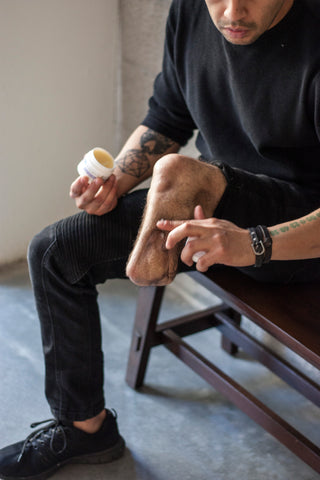Chafing Issues Solved - Techniques to reduce energy robbing friction

Is chafing a recurring theme when wearing your prosthesis? There is no doubt that dealing with friction can be exhausting. If you need a few industry techniques and tips to prevent chafing discomfort, you’ve come to the right place.
Enjoy this quick read. In this article, we’ll talk about what chafing is and what you can do about it to prevent it from ruining your day.
Chafing is caused by friction, and this happens when thighs rub together, shoes rub your heels, or your prosthetic socket rubs your residual limb. If left alone, it will eventually injure your skin and cause rashes, burning, blisters, or worse, raw skin. For prosthesis wearers, chafing can keep you out of your prosthesis for days.
So, what can you do to avoid chafing? Here are some tried and tested tips:
Prevention Chafing
1. Wear a proper fitting socket
A loose socket introduces more air which makes your limb sweat more. Sweat will then allow more movement within your socket which translates into more friction. And more friction eventually leads to skin breakdown.
Prevent this from happening by making sure that your socket fits snugly at all times. If your socket is loose, depending upon your system, wear additional prosthetic socks, try socket adjustment pads, gel roll-on or speak to your Prosthetist. You can read more about controlling your socket volume here.
2. Stay dry
Beware of too much moisture. It can cause friction and make chafing worse. So, keep your residual limb dry and comfortable by changing out of wet socks immediately and wiping sweaty prosthetic liners.
You can also keep moisture out by using a prosthetic antiperspirant, like Alps Prosthetic Anti-Perspirant Spray, or liquid powder, like Amputee Essentials Resilience Liquid Powder.
3. Protect your skin with prosthetic sheaths
Wearing sheaths under prosthetic socks is a proven technique to protect against friction. This is because their slick nylon material absorbs movement between your residual limb and socks. Nylon also allows moisture to pass through and get absorbed into the prosthetic sock, unlike cotton which stays wet and becomes the perfect storm for chafing.
Prosthetics sheaths can also provide relief and protection from friction caused by skin hanging over the inside brim of your above knee socket, also known as an adductor roll. For this particular concern, a brim sheath, like Knit-Rite A/K Brim Prosthetic Sheath, does the job well.
4. Protect high friction areas with a liner patch
Prosthetic Liner Patches, like Tamarack Glidewear Prosthetic Liner Patch, absorb stress that would otherwise cause skin irritation. Prosthetic Liner Patches are great for high friction areas, like the knee cap, the area along the back of the knee or the end of your femur bone.
5. Minimize friction with skincare products
 There is a wide range of skincare products you can use to lubricate chafe-prone areas, like prosthetic salves & balms, creams, and ointments. You may want to check out Amputee Essentials Resilience Chafe Barrier Cream, Ottobock Derma Prevent, Amputee Essentials Resilience Prosthetic Salve, and Adaptlabs Adaptskin Skin Ointment.
There is a wide range of skincare products you can use to lubricate chafe-prone areas, like prosthetic salves & balms, creams, and ointments. You may want to check out Amputee Essentials Resilience Chafe Barrier Cream, Ottobock Derma Prevent, Amputee Essentials Resilience Prosthetic Salve, and Adaptlabs Adaptskin Skin Ointment.
All these skincare products work to minimize friction and a few stop bacterial build-up so you’re somewhat protected against skin infections.
Chafe Treatment
An ounce of prevention may be better than a pound of cure, but if your skin is already chafed, you need to know how to treat it properly. Here are some helpful tips:
- Take a lukewarm shower. While hot showers may seem comforting, it will only irritate chafed skin.
- Pat your skin dry. Whatever happens, don’t rub! Follow it up with a good moisturizer or shea butter.
- If you’re dealing with raw skin, skip the moisturizer and go for a Prosthetic Salve, Adaptskin, or Ointment. Prosthetists strongly advise using these products to quickly treat skin irritation.
Follow the prevention tips above and you won’t have to deal with uncomfortable friction issues. Build a "Chafing Kit" filled with the products we’ve recommended, and you’ll find that it’s easier to take care of your skin.
If you’ve chanced upon this article a little too late, the treatment tips we’ve outlined above should have you saying bye-bye to chafing in no time.
But if your skin is red, painful, and swollen, visit your dermatologist immediately. They can check for other skin infections and prescribe a low-dose steroid ointment to calm the skin.
Related Stories
14 Superfoods that Promote Wound Healing
Chafing Cream: What Is It and How to Use It
Your Skin's Barrier: Why it's such a big deal!
5 Realities of Your Suture Scar Line
8 Summer Skin and Prosthetic Problems
5 Reasons Why You Should Stop Using Antibacterial Soaps, Bars, and Gels
Embracing Comfort: 5 Tips to Stop Skin Irritation After Taking Delivery of a New Prosthesis










































































